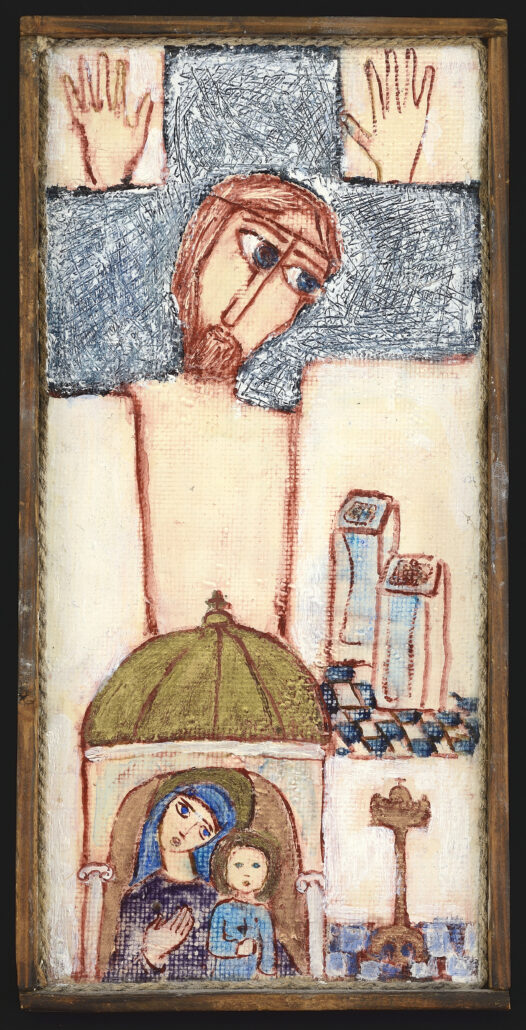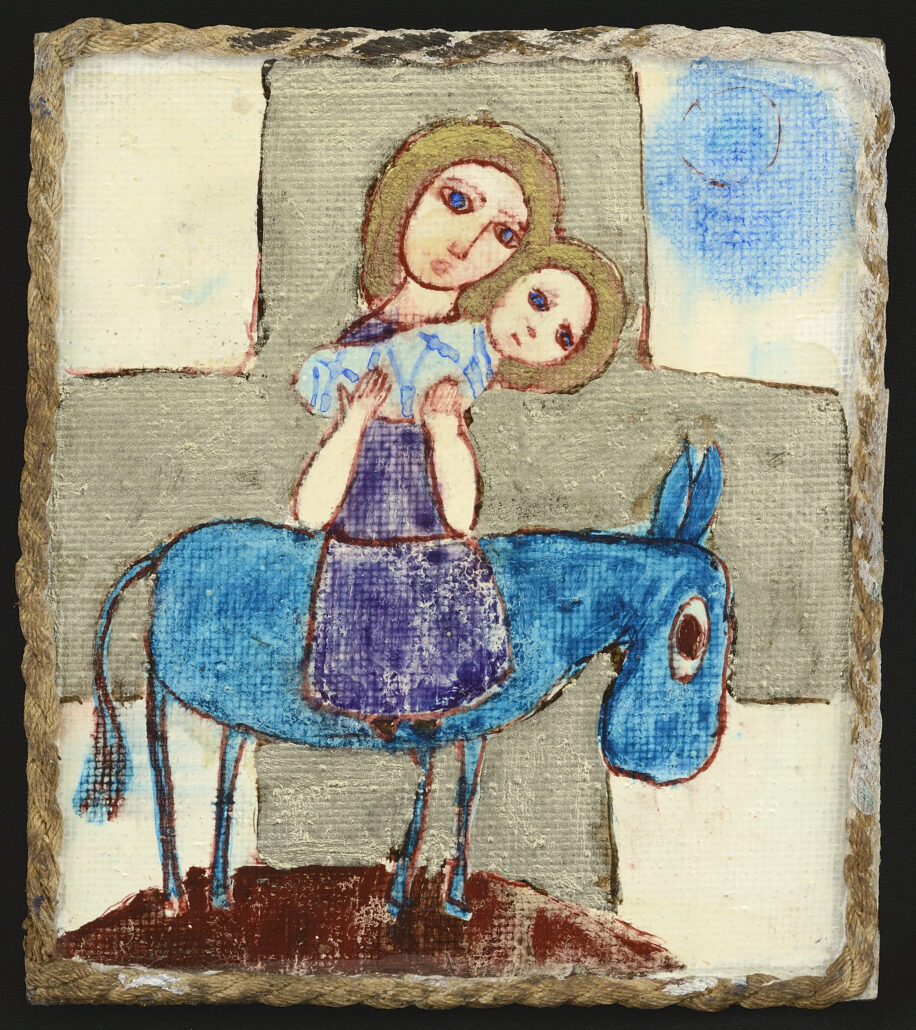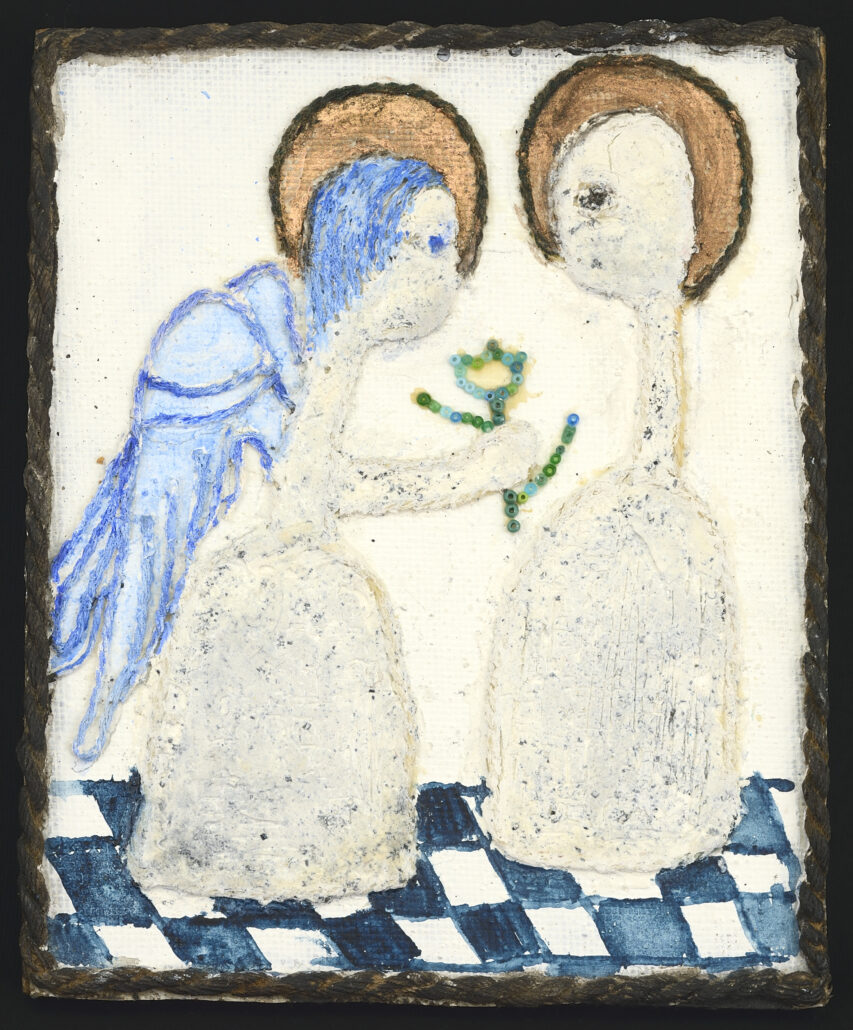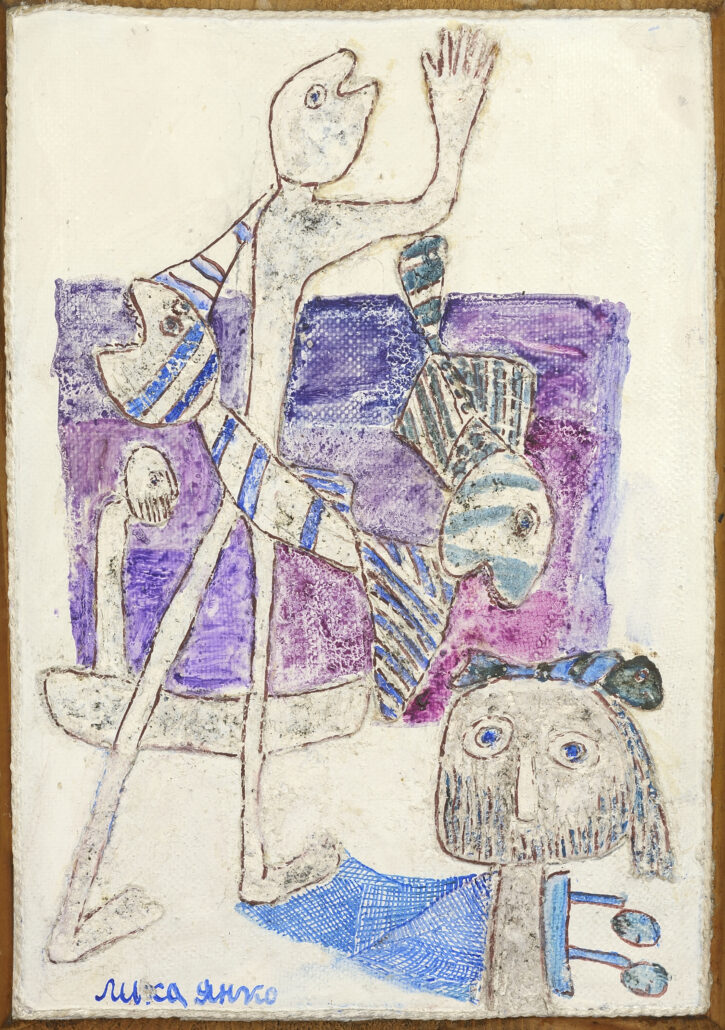Icon painting for children
“The name of Lika Yanko is a magnet that attracts everyone who understands art in this country” – says Krasimir Iliev at the opening of an exhibition of the artist (Petrov 2020). This will certainly happen at the Christmas auction of the Enakor Auction House, which offers works by the famous master, a favorite of connoisseurs of fine art.
It would not be an exaggeration to call Lika Yanko one of the few martyrs of Bulgarian modernism – defiant to the urge of communist-socialist realism, swept away but not succumbing to its terror or its perverse temptations.
Not only that, but instead of falling into depression or becoming angry as a result, just the opposite happened (Nyagolova 2020). In her decades of reclusive experimentation and laboring over her modernist models and concepts, Lika produced from her inner world a rich, warm, bright, pure, loving, radiant, shining artistic world marked by the positivity of her extraordinary individuality and strength of character.
In her reclusive years, European connoisseurs noticed her, and representatives of many embassies bought her works. It was only ten years before her death in 2001 that the public in Bulgaria appreciated her. In the years that followed, her popularity grew exponentially, including in the art market.
The martyr’s biography, creativity as art therapy
Lika Yanko’s martyric, traumatic life began long before the terror of socialist realism. First, she was marked with ancestral trauma even before her birth. Her parents originated from Vlach Christian villages west of Lake Ohrid, in the Korça region of Albania (Avramov 2019). Her father was from the village of Grabova (Avramov 2019, Grabovë e Sipërme), where, by the way, the first Bulgarian Patriarch Cyril was from. Her mother was from the village of Langa, Pogradets municipality (Farka 2018, Langa). Her father’s cousin was murdered in the village. According to traditional custom law in these communities, the murder should be responded to reciprocally (Avramov 2019, Nyagolova 2004). Following the execution of the sinister archaic law, her father Lazar Yanko Grabova, together with his wife Ephrosina and their two children, moved to Sofia, where the third child, Evangelina Lazar Yanko (with variants Evangelia Yanko Grabova, Ivangelina Yankova Grabova), was born. The date of birth is uncertain, 6-7 different dates are known in the period 1922-1932 (Iliev 2019), but it is most likely 19 March 1928.
Lika experienced her first personal traumatic incident at the age of ten – she had fallen out of a tree, undergone a complicated spinal surgery and spent a year lying in a trough. In the years that followed, she was forbidden to make sudden movements, go out alone or play with children (Iliev 2019). The experience of successfully recovering from the physical, psychological and social traumas prepared her to survive the vilification, rejection from the art guild and reclusive life of her later years calmly, humbly and even positively.
Yanko received an excellent education at the French Catholic maiden college “St. Joseph”. There she was introduced to European literature and the work of the French Impressionists. She showed artistic talent and was accepted into the class of Acad. Ilia Petrov in the Fine Arts Department of the State Academy of Fine Arts in 1945, where she graduated in 1951. She was one of the first class of students at the academy to be crushed by the forcibly imposed doctrine of imitation of Soviet socialist realism (Iliev 2019:27).
Disobeying violence, Lika did not participate in artistic life for a long time. In the early 1960s, she took part in a few general exhibitions, but received only criticism for succumbing to Western influences. That is, until the great trauma of her solo exhibition in 1967 – the artist was accused of formalism and avant-gardism, the exhibition was cancelled a few days after the opening, and her paintings were literally thrown into the street (Avramov 2019). After this incident, she withdrew completely and devoted herself to reclusive work – she painted, but no one saw her paintings. She made a living painting Easter eggs for St. Alexander Nevsky Cathedral (Nyagolova 2020). Her reclusive life was interrupted only in 1981, when she was noticed by Lyudmila Zhivkova and invited to make an exhibition. This exhibition achieved great success and the works were highly appreciated. Nevertheless, Yanko continued to stay away from the artistic life in Bulgaria.
During her reclusive years, every summer and autumn, she visited the Rhodope Mountain and Sozopol together with her female artist friends. She drew inspiration for themes and subjects for her artistic experiments from these places – from the life of the Pomaks in the mountains and the Greeks at the sea. During this period, she was noticed and appreciated by representatives of Western European embassies, who bought many of her paintings. Her works have been shown in exhibitions in Stockholm, Basel, Paris and other European cities. Yanko’s work became known around the world long before it was noticed and appreciated in her homeland.
When we look at Lika Yanko’s works chronologically arranged, we immediately understand how it happened that she overcame the many traumas in her life with some unusual strength, humility, and even with ease and irony. Anyone who has any insight into art therapy will immediately notice that the vast majority of her work bears the hallmarks of art therapy assignments. A long art-therapeutic process also seems to be present in the author’s constant experimentation, in the succession of changes in style and personal techniques.
“I love anything that is crazy, weird, and extraordinary!”
This is Lika’s motto from the first page of her school notebook (Avramov 2019) and her work shows that she followed it for the rest of her life. Many scholars have noted her main theme – the sacred, expressed in Orthodox-Christian, pagan, folkloristic, esoteric myth-poetic and purely poetic signs, figures, and compositional unities (Krumova 2002, Iliev 2019).
The most insightful researcher and her great admirer during her lifetime, Dimitar Avramov, characterized her work as follows (Avramov 2019): “For many of her compositions she holds the key to their hidden symbolism. Without her explanations, always extremely inquisitive by the way, many of these pieces turn into enigmatic signs, which naturally does not diminish in any way their suggestive impact. To characterize this personal, subjective-confessional aspect of her art, we must use the term ‘individual mythology’.”
“Everything is stylized and aestheticized. … Nostalgia for Heaven permeates all of Lika’s work. It is present in all of her themes, motifs, and subjects, where we see mythical gods and fishermen, zodiacal personifications and signs, pastoral scenes. We see flying birds, pantheistically related suns, stars, planets, and people; a Christian pantheon, Christian symbolism and imagery; children’s games and melancholic clowns, where the music of the Celestial Spheres and the musical-poetic myth of Orpheus and Eurydice resound.
The nostalgia for Heaven is also imprinted in the artist’s style: a return to the innocence of childhood – in look, feeling, fantasy, drawing, imagery. And in her passion for collecting pebbles, glass, beads, rope, string, tin stoppers, wood splinters, and shavings, and patiently gluing them to the canvas to fix forever her strange visions – always poetic, always fascinating.”
We would like to add one feature, unnoticed so far in the research on Lika Yanko – her Albanian-Vlach origin. The Southern Vlachs (in Bulgarian – Vlasi, Aromani) are descendants of the ancient Romanized Thracians, who in the Middle Ages were strongly Hellenized through Orthodoxy. This rich and diverse ethno-cultural background is reflected in the strangeness and oddity of Lika, in its unusual, perhaps always unfinished and expanded identity. It reflects her eternal “foreignness” in a Bulgarian context (socialist and post-socialist), but also her deeply hidden closeness to Bulgarians through the Thracian cultural heritage.
Lika’s Albano-Vlach background is directly reflected in her deep interest in Orthodox themes, in the life of the Pomaks in the Rhodope Mountain, sacred to the Thracians, and in the life of the Greeks in Sozopol (ancient Apollonia Pontica), as well as in the magnificent blending of these three themes in the abstractions of her works. It is reflected in the choice of themes and subjects from ancient and Old Testament mythology, in the New Testament subjects. It is reflected in her blending of Orthodox and ancient Greek artistic styles, and her interest in the occult. A connection with the artistic characteristics of Thracian art can be felt in the deliberately chosen ‘naivism’ and ‘primitivism’ of her images, compositions and pictorial techniques, as well as in the abstraction, stylisation and geometrisation characteristic of her vivid style.
What works by Lika Yanko you can win at the Christmas auction
In our Christmas Auction, you will have the opportunity to win several works by Lika Yanko from her mature period – the 1980s and early 1990s – when her abstract style and personal artistic technique were already fully formed. The works are in the themes of the sacred and the divine, executed in her characteristic style of “primitivism” and “naivism”. Most of them are on Orthodox themes, with iconic subjects representing types of the Virgin Mary and the Virgin and Child – “Annunciation” (she calls it “Blagovest” which means “Annunciator”), “The Flight into Egypt“, “Virgin Hodegetria“, “Virgin Eleusa” and mixed types.
All researchers describe her works in this style as children’s drawings. We know, however, that Yanko had a very good academic background and that this style was consciously pursued, which is why we interpret (with all conventions) the paintings with Orthodox subjects not as icons painted by children, but as “icon painting for children”. The artist herself says that her paintings are best understood by children, “… because childhood has accompanied me all my life. As a child I loved to look at the sky, to watch the clouds move. I created my drawings that way” (Dimitrov 1999). Why might it have come to Lika Yanko’s mind to paint “icons for children”? Probably because she carefully read the Gospel texts – according to Luke, 18, 15-17 the kingdom of God belongs to children. And probably also because of one of her favourite authors (writer and illustrator) – Exupéry with his “Little Prince” (Grozdanov 2015).
At the time of so-called “developed” or “mature” socialism (whatever that meant), when the practicing of all religions was strictly forbidden, Lika Yanko took care of those who were seeking to enter the kingdom of God. She created modernist works that were not the religious canonical icons (the veneration of which could be repressed), but icons as if for children. That this concern was genuine is attested by the vast number of works of the same subject and type, miniature, as for a domestic iconostasis – dozens of such versions of the Virgin and Child are known to exist.
Only one of the works in the auction is different – a subject with fish and fishermen, a variant of “Neptune. Inhabitants of the Sea“. It may have Christian symbolism in it. The central figure is of a fish-man with two fish around him. The fish is a visual symbol of Christ, and with two fish Christ feeds the crowd. The fishermen in a boat are reminiscent of the apostles who were fishermen. In this work, however, the pagan and occult symbolism seems to prevail. The two fish around the man-fish, swim in opposite directions in an ellipse, as is the iconography of the zodiac sign “Pisces” in astrology. In the foreground below is the god Neptune wearing a crown-fish, his left hand representing a boat of fishermen and his right hand representing a sea of blue net. As if with the hand-sea-net Neptune creates-represents the first man-fish. This work belongs to those works that vividly embody Lika’s personal mytho-poetic world associated with some occult beliefs, and possibly dream-visions.
Scenes with images of fish and fishermen are difficult to understand. Astrological and occult motifs seem to have been incorporated into them – for example, the age of the Pisces was to be replaced by the age of Aquarius. From an interview with Yanko (Popova 1998), from the accounts of her friends (Nyagolova 2004), and from images in her works (Iliev 2019:60-61), we have evidence that she was fascinated by astrology, by ideas of the occult New Age teachings that became popular in Bulgaria in the 1970s-1990s. The fish is an important image for her in personal terms because she is a Pisces (Popova 1998, Nyagolova 2004). She is said to have believed in reincarnation, discussed horoscopes, her zodiac sign and the zodiac signs of friends, and depicted eyes as fish (Nyagolova 2004). She mentioned that fish were a symbol of silence and mercy, and in an occult context, that fish were involved in the Creation (Popova 1998).
What Lika Yanko’s art is telling us
In Lika Yanko’s paintings, every art connoisseur attending the auction will see what he himself carries in his inner world – both what is already known to him, if he has engaged in self-exploration, and what is unknown to him, because Lika knows how to pull things out of the non-consciousness. She is capable of it for three reasons. First, because she has chosen stylistically to paint as if for children, which we all have been and to some extent continue to be. Second, her artworks are created in an art therapy process and therefore have a therapeutic effect on viewers as well. And third – her paintings function as a representation of the invisible, following her favourite lyrics from Exupery’s The Little Prince (Grozdanov 2015) – “What I see is only a shell. The most important thing is invisible.” Her paintings are like a mirror for inner worlds, both hers and ours, the viewers.
It is for this reason that Lika has refused to explain the content of her artistic symbols (Iliev 2019:62) – to allow each of us who will observe her work a glimpse into hers, but much more into our own inner world. One of the few symbols she has publicly explained is her famous white – it is the divine, “it brings purity, truth, goodness, hope; it is the colour of God, and God is love” (Racheva 2020). Therefore, the only certainty she presupposes for us is a turning to the bright sides of our human ‘invisible’. Everything else we are free to interpret according to our inner invisible worlds, which the artist graciously helps us to illuminate. As she says, “Honesty and graciousness are important to me, which is why I seek to express them in order to raise the human spirit” (Popova 1998).
Admirers of Lika Yanko’s art who would like to acquire her work from our Christmas Auction will not be disappointed – her gorgeous miniature “icons for children” are offered at very affordable starting prices. Her paintings would be an enlightenment of personal spiritual places as well as a good investment, because the market interest in Lika Yanko has been on a steady rise in recent years.
Rositsa Gicheva-Meimari, PhD,
Senior Assistant Professor at the Section of “Art History and History of Culture” and member of the Center “Bulgarian-European Cultural Dialogues” at New Bulgarian University
Bibliography
Avramov 2019: Аврамов, Димитър, Приказният свят на Лика Янко, В: Портал за култура, изкуство и общество, публикувано на 30. 01.2019. Link. Visited on 28. 10. 2023.
Getov 2017: Гетов, Красимир, 2017. Авангардна художничка от албански произход твори преди 70 години в Зверино. Публикувано на 2017 г. Link. Visited on 01. 11. 2023.
Grozdanov 2015: Грозданов, Димитър, 2015. Кураторски текст за изложбата „Седем изображения“ в СБХ, ноември 2015 г. В: „Въпреки“. Link. Visited on 02. 11. 2023.
Dimitrov 1999: Димитров, Даниел. Американският биографичен институт номинира Лика Янко за жена на годината, публикувано на 28. 08 .1999. Link. Visited on 01. 11. 2023.
Iliev 2019: Красимир Илиев, Лика Янко: общуване със сакралното. Изд. на Галерия „Лоранъ“, София, 2019.
Krumova 2002: Крумова, Ирен, 2002. Лика Янко и нейните Свети места. Рецензия за Димитър Аврамов. Лика Янко. В: в. Култура бр.25, 21 юни 2002. Link. Visited on 02. 11. 2023.
Nyagolova 2004: Няголова, Елка, 2004 . Лика Янко, за легендата – отблизо. В: Блог на галерия „Кавалет“, публикувано на 11 март, 2004. Link. Visited on 28. 10. 2023.
Nyagolova 2020: Няголова, Елка, 2020 . Писмо до Лика Янко и яйце за Великден. В: Блог на галерия „Кавалет“, публикувано на 19 март, 2020. Link. Visited on 28. 10. 2023.
Petrov 2020: Петров, Лаврен, “Общуване със сакралното” 2020. Изложба на Лика Янко (1928 – 2001) в две галерии “Лоранъ” и “Контраст”, видео, публикувано на 23. 03. 2020 г. Link. Visited on 31. 10. 2023.
Popova 1998: Попова, Мария, 1998. Лика Янко: Интервю на Мария Попова. В: LiterNet, Link. Visited on 01. 11. 2023.
Racheva 2020: Рачева, Радост-Лилия, 2020. Лика Янко:” Фернанда, аз ще ти дам картината”. Актрисата Димитрина Савова за приятелството си с голямата ни художничка. В: сп. Театър, публикувана на 22 август 2020 г. Link. Visited on 02. 11. 2023.
Choulova-Markova 2019: Чулова-Маркова, Даниела „Близката чужденка“.90 години от рождението на Лика Янко. 14 декември 2018 г. – 20 февруари 2019 г., СГХГ. В: СБХ бюлетин, 2019/1, с. 44-45. Link. Visited on 02. 11. 2023.
Langa: Ланга, статия за с. Ланга в Уикипедия. Link. Visited on 02. 11. 2023.
Grabovë e Sipërme: Grabovë e Sipërme, статия за с. Грабова в Уикипедия. Link Visited on 02. 11. 2023.
Farka 2018: Kurt Farka, Si e njoha artisten e madhe me origjinë shqiptare, Lika Janko, 24 февруари 2018. Link. Visited on 02. 11. 2023.






